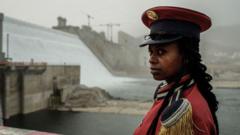Ethiopia has officially announced the completion of its monumental Grand Ethiopian Renaissance Dam (GERD) on the Blue Nile—a significant milestone that has historically led to tensions with both Egypt and Sudan. Launched in 2011 with an investment budget of $4 billion, the GERD is now regarded as Africa's largest hydroelectric power station and is a source of national pride for many Ethiopians.
The Ethiopian government views the dam as an essential project for alleviating its electricity shortages, with approximately 60% of the population lacking reliable access to power. Prime Minister Abiy Ahmed emphasized that the dam represents not just a national asset, but an opportunity for cooperative progress among nations. "To our neighbours downstream—Egypt and Sudan—our message is clear: the Renaissance Dam is not a threat, but a shared opportunity," he proclaimed.
The completion comes amid heightened fears from Egypt and Sudan, both of which rely heavily on the Nile for their fresh water supplies. Concerns have been raised that any disruption or alteration in flow caused by the dam could hamper their agricultural land and water security. Egypt has previously expressed its anxiety over the potential impact, arguing that even a slight decrease in the Nile’s water could lead to substantial agricultural losses.
In September, Ethiopia plans to officially inaugurate the dam, extending invitations to its neighboring countries as part of its outreach for collaboration. However, the leaders of Egypt and Sudan recently reiterated their discontent with what they perceive as unilateral actions by Ethiopia, which could compromise their water rights.
Despite a desire for constructive dialogue, previous negotiations between Ethiopia, Egypt, and Sudan have stalled, leaving the future of Nile resource management uncertain. As Ethiopia seeks to harness the river for its developmental needs, the balance of interests among these three countries remains a critical issue to address.



















